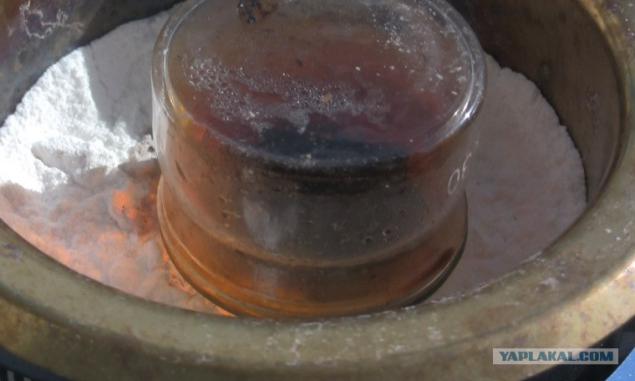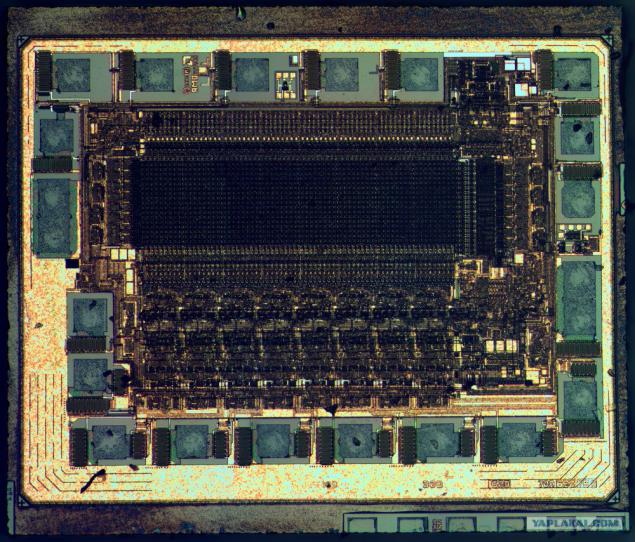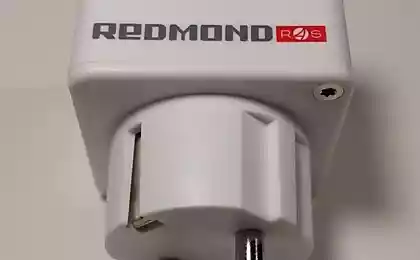582
How "open" and that chip inside her?
15 ph
Chips - are closest to being called "black box" - they really black, and inside them - remain a mystery to many.
This veil of secrecy and lift us today, and will help us in this - sulfuric and nitric acid.
Attention! Any operations with concentrated (and especially boiling) acids are extremely dangerous, and work with them is possible only using the appropriate protective equipment (gloves, glasses, apron, hood). Remember, we only have two eyes, and every single drop is enough: for all that is written here - not worth repeating.
Open
We take interest us chips, adding concentrated sulfuric acid. Bring to a boil (about 300 degrees), do not stir :-) at soda sprinkled on the bottom - to neutralize spilled acid and its vapors.
taken here

After 30-40 minutes of the plastic is carbon:

We took out and choose what goes for one more invigorating acid bath, and what is ready:

If pieces of carbon stuck firmly to the crystal, they can be removed with boiling concentrated nitric acid (but the temperature here is much lower, ~ 110-120C). Diluted acid plating eat, because it is concentrated need:

Enjoying
Some photos of someone you could have seen me.
The colors traditionally "strengthened" to the maximum - in reality, a riot of colors a lot less.
PL2303HX - converter USB & lt; & gt; RS232, are used in all sorts of Arduino and their ilk:

LM1117 - linear regulator power:

74HC595 - 8-bit shift register:

NXP 74AHC00
74AHC00 - 4 NAND (2I-NOT) element. Looking at the huge crystal size (944x854 μm) - it becomes clear that the "old" micron technology is still used. Interestingly abundance of "reserve» via to increase the yield.

Micron MT4C1024 - chip dynamic memory Mebibit 1 (220 bits). It used during the 286 and 386. The crystal size - 8662x3969μm.

AMD Palce16V8h
Chips GAL (Generic array logic) - predecessors FPGA and CPLD.
AMD Palce16V8h is a 32x64 array of AND.
Crystal size - 2434x2079μm, technology 1μm.

ATtiny13A - one of the smallest microcontrollers Atmel: 1 KB of flash memory and 32 bytes of SRAM. Crystal size - 1620x1640 μm. Technological standards - 500nm.

ATmega8 - one of the most popular 8-bit microcontroller.
Crystal size - 2855x2795μm, technological standards 500nm.

KR580IK80A (later renamed kr580vm80a) - one of the most popular Soviet processors.
It turned out that, contrary to popular belief, it is not a copy of layered Intel 8080 / 8080A (some blocks are similar, but the layout and location of the contact pads is significantly different).
The thinnest line - 6μm.

STM32F100C4T6B - the smallest microcontroller on the core ARM Cortex-M3 production STMicroelectronics. Crystal size - 2854x3123μm.

Altera EPM7032 - CPLD seen a lot, and one of the few working on 5V power. Crystal size - 3446x2252μm, technological standards 1μm.
all.

Source:
Chips - are closest to being called "black box" - they really black, and inside them - remain a mystery to many.
This veil of secrecy and lift us today, and will help us in this - sulfuric and nitric acid.
Attention! Any operations with concentrated (and especially boiling) acids are extremely dangerous, and work with them is possible only using the appropriate protective equipment (gloves, glasses, apron, hood). Remember, we only have two eyes, and every single drop is enough: for all that is written here - not worth repeating.
Open
We take interest us chips, adding concentrated sulfuric acid. Bring to a boil (about 300 degrees), do not stir :-) at soda sprinkled on the bottom - to neutralize spilled acid and its vapors.
taken here

After 30-40 minutes of the plastic is carbon:

We took out and choose what goes for one more invigorating acid bath, and what is ready:

If pieces of carbon stuck firmly to the crystal, they can be removed with boiling concentrated nitric acid (but the temperature here is much lower, ~ 110-120C). Diluted acid plating eat, because it is concentrated need:

Enjoying
Some photos of someone you could have seen me.
The colors traditionally "strengthened" to the maximum - in reality, a riot of colors a lot less.
PL2303HX - converter USB & lt; & gt; RS232, are used in all sorts of Arduino and their ilk:

LM1117 - linear regulator power:

74HC595 - 8-bit shift register:

NXP 74AHC00
74AHC00 - 4 NAND (2I-NOT) element. Looking at the huge crystal size (944x854 μm) - it becomes clear that the "old" micron technology is still used. Interestingly abundance of "reserve» via to increase the yield.

Micron MT4C1024 - chip dynamic memory Mebibit 1 (220 bits). It used during the 286 and 386. The crystal size - 8662x3969μm.

AMD Palce16V8h
Chips GAL (Generic array logic) - predecessors FPGA and CPLD.
AMD Palce16V8h is a 32x64 array of AND.
Crystal size - 2434x2079μm, technology 1μm.

ATtiny13A - one of the smallest microcontrollers Atmel: 1 KB of flash memory and 32 bytes of SRAM. Crystal size - 1620x1640 μm. Technological standards - 500nm.

ATmega8 - one of the most popular 8-bit microcontroller.
Crystal size - 2855x2795μm, technological standards 500nm.

KR580IK80A (later renamed kr580vm80a) - one of the most popular Soviet processors.
It turned out that, contrary to popular belief, it is not a copy of layered Intel 8080 / 8080A (some blocks are similar, but the layout and location of the contact pads is significantly different).
The thinnest line - 6μm.

STM32F100C4T6B - the smallest microcontroller on the core ARM Cortex-M3 production STMicroelectronics. Crystal size - 2854x3123μm.

Altera EPM7032 - CPLD seen a lot, and one of the few working on 5V power. Crystal size - 3446x2252μm, technological standards 1μm.
all.

Source:
























